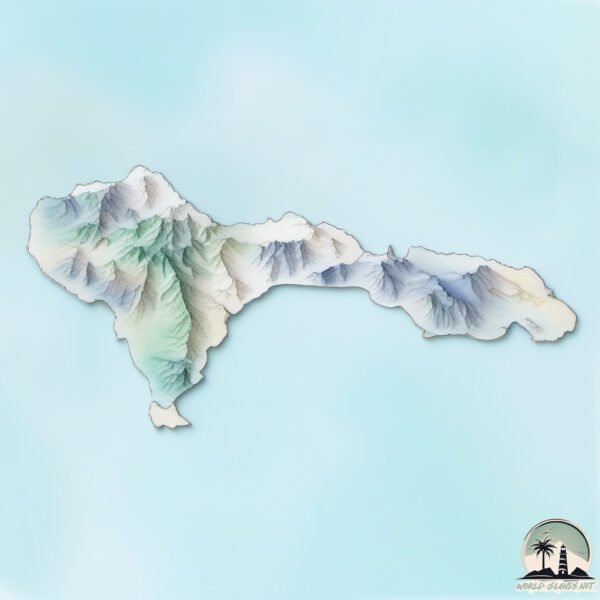Sao Nicolau

Welcome to Sao Nicolau, a Dry island in the North Atlantic Ocean, part of the majestic Atlantic Ocean. This guide offers a comprehensive overview of what makes Sao Nicolau unique – from its geography and climate to its population, infrastructure, and beyond. Dive into the details:
- Geography and Size: Explore the island’s size and location.
- Climate and Weather: Weather patterns and temperature.
- Topography and Nature: Uncover the natural wonders of the island.
- Infrastructure and Travelling: Insights on reaching, staying, and making the most of your visit.
- News and Headlines: Latest News.
Geography and size of Sao Nicolau
Size: 347.8 km²
Coastline: 144.2 km
Ocean: Atlantic Ocean
Sea: North Atlantic Ocean
Continent: Africa
Sao Nicolau is a Large Island spanning 348 km² with a coastline of 144 km.
Archipel: Cape Verde – An island country in the central Atlantic Ocean, known for its Creole Portuguese-African culture, music, and volcanic landscapes.
Tectonic Plate: Africa – One of the world’s largest tectonic plates, covering the African continent and parts of the surrounding oceans, known for its stability with some active rift zones.
The geographic heart of the island is pinpointed at these coordinates:
Latitude: 16.59862645 / Longitude: -24.25664973
Climate and weather of Sao Nicolau
Climate Zone: Dry
Climate Details: Hot Deserts Climate
Temperature: Hot
Climate Characteristics: Dominated by extremely hot temperatures, this climate is marked by minimal rainfall and barren landscapes. Nights often experience drastic temperature drops.
Topography and nature of Sao Nicolau
Timezone: UTC-01:00
Timezone places: Atlantic/Cape_Verde
Max. Elevation: 1118 m
Mean Elevation: 261 m
Vegetation: Rocky Terrain
Tree Coverage: 7%
The mean elevation is 261 m. The highest elevation on the island reaches approximately 1118 meters above sea level. The island is characterized by Plateau: Elevated flatlands rising sharply above the surrounding area, with a maximum elevation over 500 meters but a mean elevation less than 300 meters, forming unique highland areas on islands.
Dominating Vegetation: Rocky Terrain
Landscapes dominated by gravel, rock, and stone, with little to no vegetation. These areas are often found in mountainous regions or deserts. Sao Nicolau has a tree cover of 7 %.
Vegetation: 11 vegetation zones – Exceptionally Diverse Island
Islands with more than ten vegetation zones are among the most ecologically rich and varied in the world. These islands are akin to miniature continents, boasting an incredible array of ecosystems. The sheer range of habitats, from high peaks to deep valleys, rainforests to deserts, creates a mosaic of life that is unparalleled. They are crucial for conservation and ecological studies.
Infrastructure and Travelling to Sao Nicolau
Does the island have a public airport? yes.
Sao Nicolau has a public and scheduled airport. The following airports are located on this island: Preguiça Airport.
Does the island have a major port? no.
There are no major ports on Sao Nicolau. The closest major port is PORTO GRANDE, approximately 69 km away.
The mean population of Sao Nicolau is 37 per km². Sao Nicolau is Gently Populated. The island belongs to Cabo Verde.
The name of the island resonates across different cultures and languages. Here is how it is known around the world: Arabic: ساو نيكولاو; German: São Nicolau; Spanish: Isla de São Nicolau; French: São Nicolau; Portuguese: Ilha de São Nicolau; Russian: Сан-Николау; Chinese: 聖尼古勞島
Continuing your journey, Ilha de Santa Luzia is the next notable island, situated merely km away.
Sao Nicolau - the most beautiful island of Cape Verde



Cabo Verde is classified as Developing region: Regions characterized by lower income levels, with economies in the process of industrialization and modernization. The level of income is Lower middle income.
News – Latest Updates and Headlines from Sao Nicolau
Stay informed with the most recent news and important headlines from Sao Nicolau. Here’s a roundup of the latest developments.
Please note: The data used here has been primarily extracted from satellite readings. Deviations from exact values may occur, particularly regarding the height of elevations and population density. Land area and coastline measurements refer to average values at mean high tide.
